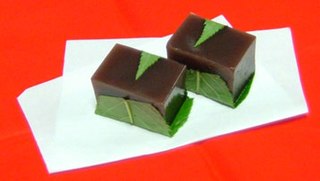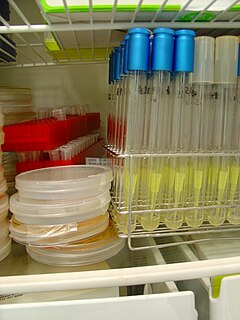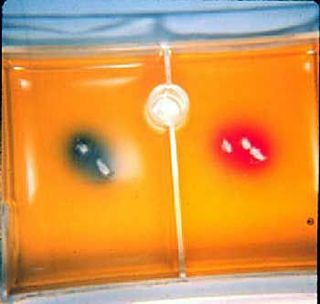Related Research Articles

Agar or agar-agar is a jelly-like substance, obtained from red algae.

An agar plate is a Petri dish that contains agar as a solid growth medium plus nutrients, used to culture microorganisms. Sometimes selective compounds are added to influence growth, such as antibiotics.

A microbiological culture, or microbial culture, is a method of multiplying microbial organisms by letting them reproduce in predetermined culture medium under controlled laboratory conditions. Microbial cultures are foundational and basic diagnostic methods used as a research tool in molecular biology.

Bacteriological water analysis is a method of analysing water to estimate the numbers of bacteria present and, if needed, to find out what sort of bacteria they are. It represents one aspect of water quality. It is a microbiological analytical procedure which uses samples of water and from these samples determines the concentration of bacteria. It is then possible to draw inferences about the suitability of the water for use from these concentrations. This process is used, for example, to routinely confirm that water is safe for human consumption or that bathing and recreational waters are safe to use.

A growth medium or culture medium is a solid, liquid or semi-solid designed to support the growth of microorganisms or cells, or small plants like the moss Physcomitrella patens. Different types of media are used for growing different types of cells.

MacConkey agar is an indicator, a selective and differential culture medium for bacteria designed to selectively isolate Gram-negative and enteric bacilli and differentiate them based on lactose fermentation. The crystal violet and bile salts inhibit the growth of Gram-positive organisms which allows for the selection and isolation of gram-negative bacteria. Enteric bacteria that have the ability to ferment lactose can be detected using the carbohydrate lactose, and the pH indicator neutral red.

Chocolate agar (CHOC) or chocolate blood agar (CBA), is a nonselective, enriched growth medium used for isolation of pathogenic bacteria. It is a variant of the blood agar plate, containing red blood cells that have been lysed by slowly heating to 80°C. Chocolate agar is used for growing fastidious respiratory bacteria, such as Haemophilus influenzae and Neisseria meningitidis. In addition, some of these bacteria, most notably H. influenzae, need growth factors such as nicotinamide adenine dinucleotide and hemin, which are inside red blood cells; thus, a prerequisite to growth for these bacteria is the presence of red blood cell lysates. The heat also inactivates enzymes which could otherwise degrade NAD. The agar is named for its color and contains no chocolate products.

Burkholderia cepacia complex (BCC), or simply Burkholderia cepacia, is a group of catalase-producing, lactose-nonfermenting, Gram-negative bacteria composed of at least 20 different species, including B. cepacia, B. multivorans, B. cenocepacia, B. vietnamiensis, B. stabilis, B. ambifaria, B. dolosa, B. anthina, B. pyrrocinia and B. ubonensis. B. cepacia is an opportunistic human pathogen that most often causes pneumonia in immunocompromised individuals with underlying lung disease. Patients with sickle-cell haemoglobinopathies are also at risk. The species also attacks young onion and tobacco plants, as well as displaying a remarkable ability to digest oil.
TCBS may refer to:

Aesculin, also called æsculin or esculin, is a coumarin glucoside that naturally occurs in the trees horse chestnut, California buckeye, prickly box, and daphnin. It is also found in dandelion coffee.

Dermatophyte test medium (DTM) is a specialized agar used in medical mycology. It is based on Sabouraud's dextrose agar with added cycloheximide to inhibit saprotrophic growth, antibiotic to inhibit bacterial growth, and phenol red a pH indicator. The pH indicator is useful in distinguishing a dermatophyte fungus, which utilizes nitrogenous material for preferred metabolism, producing alkaline by-products, imparting a red color change to the medium. Typical saprotrophic fungi utilize carbohydrates in the medium producing acidic by-products and no red color change.
XLT Agar Is a selective culture medium for the isolation and identification of salmonellae from food and environmental samples. It is similar to XLD agar however the agar is supplemented with the surfactant, Tergitol 4, which causes inhibition of Proteus spp. and other non-Salmonellae. Successful growth of Salmonella will result in growth of red colonies with a black centre.

Mannitol salt agar or MSA is a commonly used selective and differential growth medium in microbiology. It encourages the growth of a group of certain bacteria while inhibiting the growth of others. This medium is important in medical laboratories as one method of distinguishing pathogenic microbes in a short period of time. It contains a high concentration of salt (NaCl), making it selective for most Gram-negative and some Gram-positive bacteria since this level of salt is inhibitory to most other bacteria. It is also a differential medium for mannitol-fermenting staphylococci, containing carbohydrate mannitol and the indicator phenol red, a pH indicator for detecting acid produced by mannitol-fermenting staphylococci. Staphylococcus aureus produces yellow colonies with yellow zones, whereas other coagulase-negative staphylococci produce small pink or red colonies with no colour change to the medium. If an organism can ferment mannitol, an acidic byproduct is formed that causes the phenol red in the agar to turn yellow. It is used for the selective isolation of presumptive pathogenic (pp) Staphylococcus species.
Plate Count Agar (PCA), also called Standard Methods Agar (SMA), is a microbiological growth medium commonly used to assess or to monitor "total" or viable bacterial growth of a sample. PCA is not a selective medium. The composition of plate count agar may vary, but typically it contains (w/v):
The ' tests are a group of individual tests used in microbiology lab testing to identify an organism in the coliform group. A coliform is a gram negative, aerobic anaerobic rod which produces gas from lactose within 48 hours. The presence of some coliforms indicate fecal contamination.

Hektoen enteric agar is a selective and differential agar primarily used to recover Salmonella and Shigella from patient specimens. HEA contains indicators of lactose fermentation and hydrogen sulfide production; as well as inhibitors to prevent the growth of Gram-positive bacteria. It is named after the Hektoen Institute in Chicago, where researchers developed the agar.

Sabouraud agar or Sabouraud dextrose agar (SDA) is a type of agar growth medium containing peptones. It is used to cultivate dermatophytes and other types of fungi, and can also grow filamentous bacteria such as Nocardia. It has utility for research and clinical care.
Thiosulfate-citrate-bile salts-sucrose agar, or TCBS agar, is a type of selective agar culture plate that is used in microbiology laboratories to isolate Vibrio species. TCBS agar is highly selective for the isolation of V. cholerae and V. parahaemolyticus as well as other Vibrio species. TCBS agar contains high concentrations of sodium thiosulfate and sodium citrate to inhibit the growth of Enterobacteriaceae. Inhibition of Gram-positive bacteria is achieved by the incorporation of ox gall, which is a naturally occurring substance containing a mixture of bile salts and sodium cholate, a pure bile salt. Sodium thiosulfate also serves as a sulfur source and its presence, in combination with ferric citrate, allows for the easy detection of hydrogen sulfide production. Saccharose (sucrose) is included as a fermentable carbohydrate for metabolism by Vibrio species. The alkaline pH of the medium enhances the recovery of V. cholerae and inhibits the growth of others. Thymol blue and bromothymol blue are included as indicators of pH changes.
In microbiology, the term isolation refers to the separation of a strain from a natural, mixed population of living microbes, as present in the environment, for example in water or soil flora, or from living beings with skin flora, oral flora or gut flora, in order to identify the microbe(s) of interest. Historically, the laboratory techniques of isolation first developed in the field of bacteriology and parasitology, before those in virology during the 20th century. Methods of microbial isolation have drastically changed over the past 50 years, from a labor perspective with increasing mechanization, and in regard to the technology involved, and hence speed and accuracy.
References
| This microbiology-related article is a stub. You can help Wikipedia by expanding it. |